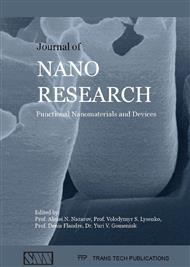p.114
p.121
p.134
p.151
p.162
p.169
p.178
p.191
p.202
Capacitive Properties of MIS Structures with SiOx and SixOyNz Films Containing Si Nanoclusters
Abstract:
he negative differential capacity has been observed in case of MIS structures with SiOx and SixOyNz films containing Si nanoclusters. It has been shown that existence of negative differential capacity depends on charge state of Si nanoclusters or electron traps in the insulating matrix. In case of SixOyNz films the two peaks have been revealed in C-V characteristics connected with Si nanoclusters and electron traps. The low-temperature annealing of SixOyNz films in hydrogen passivates the electron traps caused by Si dangling bonds and as a result the peak in C-V characteristics connected with electron traps disappears. The following low-temperature annealing in vacuum caused the some effusion of hydrogen from the film and appearance of electron traps and connected with them capacity shoulder on C-V characteristics. It has been shown, that the frequency and temperature dependences of the negative differential capacitance in C-V curves can be successfully used for the determination of nanoclusters and traps parameters for the samples with the nanoclusters embedded in SiO2 or SixOyNz films.
Info:
Periodical:
Pages:
162-168
Citation:
Online since:
February 2016
Authors:
Price:
Сopyright:
© 2016 Trans Tech Publications Ltd. All Rights Reserved
Share:
Citation:


